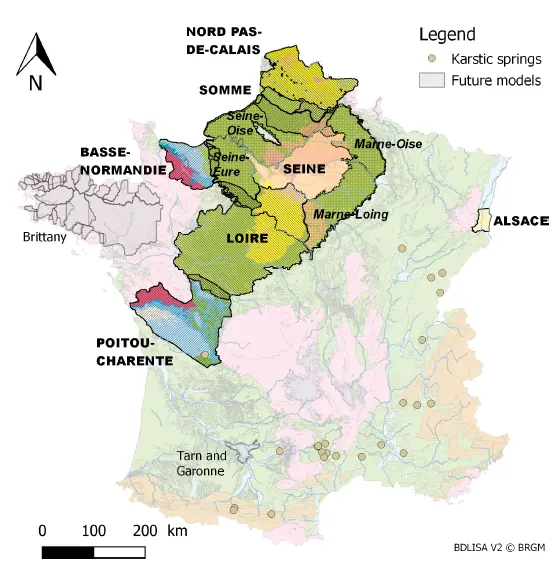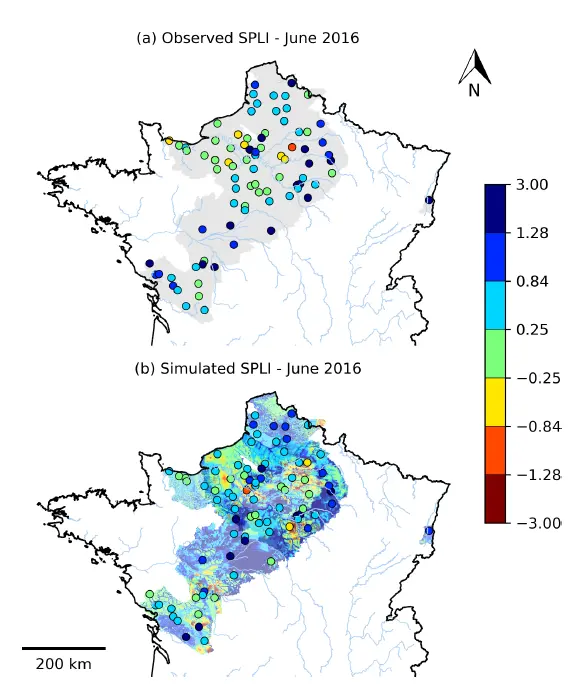AQUI-FR
plataforma nacional de modelação hidrogeológica (França)
AQUI-FR
Voltar
Download the practice
People in charge of the innovative practice :
Jean-Pierre VERGNES – jp.vergnes@brgm.fr
AQUI-FR is a national hydrogeological modeling platform designed as a tool to valorize hydrogeological modeling work done in France. Started in 2014, AQUI-FR aims to bring together within a single digital platform hydrogeological models developed by different research institutes. AQUI-FR thus brings together 8 partners (ENS, CERFACS, BRGM, Ecole des Mines PARIS, Météo France, Géosciences Rennes, LHyges, UMR METIS) with the aim of developing a better knowledge of past, present, and future groundwater resources. AQUI-FR aims to implement forecasts of groundwater evolution in France, on time scales ranging from days to seasons (+6 months), and from atmospheric forecasts via standardized piezometric indicators. The platform also allows to carry out prospective modelling (up to 2100), based on hydrogeological modelling developed and used by water managers when they exist, and to promote the development of these modelling when they do not. A computer structure allows the association of 3 hydrogeological models (EROS, MARTHE, EauDyssée), a water and energy flow model (SURFEX), and an atmospheric analysis system (SAFRAN). The dynamic coupling of the models is provided by the OpenPALM coupler. The AQUI-FR platform is deployed on the operational machines of Météo-France and benefits from its support for daily monitoring. The platform has been used on a total of 14 distributed aquifer applications and 23 applications on karst systems. In the future, other regional models will be integrated to extend the spatial coverage.

Responsible entity
Several entities are responsible for the AQUI-FR platform. The Geoscience department of the ENS is the coordinator of the platform.
Institutional setting
As the national model is built on existing hydrogeological applications, each partner remains the owner of its hydrogeological model and the results are available to the general public.
Geographical setting
The simulations from the platform cover 35% of metropolitan France. The EauDyssée model covers Basse-Normandie, Somme, Seine, Loire and four sub-systems: Marne-Loing, Marne-Oise, Seine-Eure, Seine-Oise. The MARTHE model covers Alsace, Basse-Normandie, Nord Pas-de-Calais, Poitou-Charentes, and Somme. Finally, the EROS model covers 23 karst systems (median size 99 km²).
Detailed explanation
The modeling platform represents the main hydrological processes occurring in watersheds, from precipitation to groundwater flow. In its current form, the AQUI-FR system includes three hydrogeological modeling software covering 11 sedimentary aquifers and 23 karst systems: the hydrogeological numerical platform EauDyssée, the MARTHE software and the EROS software used for karst systems. The three software are embedded in an application developed with the OpenPALM coupling syste.

A preliminary step is performed to estimate groundwater recharge and surface runoff with SURFEX taking into account SAFRAN atmospheric forcing before launching OpenPALM. This preliminary step gives access to 60 years of daily groundwater recharge and runoff at a regular resolution of 8 km over the entire metropolitan area.
Historical overview
The objectives of the first phase (since 2014) was to show the feasibility of such a tool via the construction of the AQUI-FR computer structure and the first evaluations, as well as to ensure the legal possibilities of exploiting hydrogeological applications in operational, and finally, to identify the elements of interest for the water managers. The construction of the AQUI-FR structure required several steps: (i) to gather the hydrogeological models on the same computer structure that can be mobilized in operational use, (ii) to integrate the different hydrogeological applications available, (iii) to converge towards a homogeneous treatment on a national scale, via at least the use of a common atmospheric forcing, (iv) to recalibrate the applications to make them more compatible with this new forcing.
This work was accompanied by an effort to process the input and output data. An important aspect of the input data is the integration of groundwater withdrawals over the simulated periods, which are difficult to acquire over long periods and for recent periods (2-year delay). The management of output variables requires specific work, taking into account the variables of interest for managers (variable, depth or geological layer, estimation period, estimation domain) and numerical constraints (disk volumes, calculation time). In parallel, two development efforts were carried out, in order to: (i) include a representation of the basement aquifers, with numerical experiments carried out on the Brittany aquifers, and (ii) to allow a correction of the initial states of the aquifers by integrating the available piezometric data.
Evidence of benefits from implementation
The results of the AQUI-FR project confirm the feasibility of bringing together independent hydrogeological models developed in different research institutes in the same coupling platform. All these models were initially developed and calibrated over shorter periods with heterogeneous geological and meteorological databases, but the evaluation of the long-term simulations that has been carried out shows a good comparison with the observations available for the same period. It confirms the relevance of using the AQUI-FR as a tool for long-term impact studies.

The other advantage of this platform is in its modularity. The AQUI-FR platform encourages the development of groundwater modeling where it is lacking and, more generally, it has the potential to be a valuable tool for many applications in water resources management and in water quality studies. research, for example in climate change studies and seasonal forecasts
Replication potential in SUDOE region
The trigger for implementing the practice was the publication of the Explore 2070 project results, which showed a disparate analysis, and thus the idea emerged to harmonize the modeling results to make forecasts. From a technical point of view, few obstacles were encountered. The obstacles encountered were in relation to intellectual property. Indeed, it was necessary to reach an agreement on the sharing of the source code of the Marthe model to implement it on the Météo France platform. On the conceptual side, the models were not perfectly calibrated: some model outputs overlap. From an administrative point of view, it was necessary to convince the regions, because the hydrogeological models were developed within the regional entities of BRGM. Finally, from a functional point of view, the maintenance of the platform requires a permanent researcher per partner. The project was also able to benefit from subsidies (about 100 k€ / year).
Future outlook
In terms of evolution, the project offers several perspectives in terms of: (i) improvement of physical processes: better integration of basement and karst aquifers, and (ii) development: evolution of numerical codes and techniques.
This project also offers prospects for development outside of France, in the French overseas departments and territories, but also prospects within the framework of PEPR (One Water program).
In the future, other regional models will be included to extend the coverage of AQUI-FR (bedrock aquifers located in Brittany). A new modeling method based on a rainfall-runoff model will be used to provide upstream river flows as boundary conditions for the MARTHE models that require it. Finally, since errors in the initial conditions can significantly alter the skill of the forecast, studies dedicated to data assimilation to improve the initial state conditions are also performed in parallel.
Key points of the innovative method
> Multi-model numerical platform
> Daily to seasonal forecasts
> Prospective modeling (up to 2100)
Acknowledgements
The innovative practice was suggested by Jean-Pierre VERGNES (BRGM) who also participated in the interview.
References
Habets, F., Amraoui, N., Caballero, Y., Thiéry, D., Vergnes, J-P., Morel, T., Le Moigne, P., Roux, N., de Dreuzy, J-R., Longuevergne, L., Ackerer, P., Maina, F., Besson, F., Etchevers, P., Regimbeau, F., Viennot, P. (2017). Plate-forme de modélisation hydrogéologiques nationale AQUI-FR. Rapport final de 1ère phase 2014-2016. http://www.geosciences.ens.fr/wp-content/uploads/2019/07/Rapport_fin_phase1_Aqui-FR_VF.pdf
Habets, F., Amraoui, N., Caballero, Y., Thiéry, D., Vergnes, J-P., Morel, T., Le Moigne, P., Leroux, D., Roux, N., Courtois, Q., de Dreuzy, J-R., Ackerer, P., Besson, F., Etchevers, P., Regimbeau, F., Vincendon, B., Gallois, N., Viennot, P. (2018). Evolution de la ressource en eau souterraine passée, présente et future estimée par AQUI-FR. Rapport d’étape. http://www.geosciences.ens.fr/wp-content/uploads/2019/07/rapport_d_etape_AquiFR_Juil_2018.pdf
Thiéry, D. (2015a). Code de calcul MARTHE – Modélisation 3D des écoulements dans les hydrosystèmes – Notice d’utilisation de la version 7.5 (MARTHE: Modeling software for groundwater flows), BRGM/RP-64554-FR, BRGM, Orléans.
Thiéry, D. (2018a). Logiciel ÉROS version 7.1 – Guide d’utilisation, Rapport final, BRGM/RP-67704-FR, BRGM, Orléans.
aquifer
NOTÍCIAS
Descubra mais sobre as notícias do projeto AQUIFER e sobre a gestão de aquíferos
NOTÍCIAS AQUIFER
Descrição e objectivos do projecto
The scientific community recommends a substantial improvement in the knowledge of aquifers, the establishment of reliable monitoring networks and a greater involvement of the administration and users to achieve a sustainable management of aquifers. The main objective...
Informação sobre o projecto
A Comunidade de Utilizadores de Água do Delta Llobregat concebeu bacias de recarga em Molins de Rei para recarregar o aquífero do Baix Llobregat. Vista de uma das bacias de recarga durante a fase de teste A Comunidade de Utilizadores de Água de Llobregat Delta é um...
Histórias de sucesso na gestão das águas subterrâneas
Compilação de histórias de sucesso na gestão das águas subterrâneas. Ao longo do mês de Abril, os 30 casos de práticas inovadoras na gestão das águas subterrâneas já foram seleccionados pelos agrupamentos que participam no projecto: PPA, CWP e AV. A tarefa começou com...
PROPONHA UMA
PRÁTICA INOVADORA
Está a desenvolver ou implementar uma prática inovadora em matéria de gestão de aquíferos e deseja referência-la na plataforma do projeto AQUIFER?
Preencha o formulário e faça uma proposta aos parceiros do projeto AQUIFER.
THE E-BOOK
O Aquífero oferece uma gama de práticas inovadoras de gestão da água. Pode descarregar todas as nossas fichas técnicas aqui.
E-BOOK DE PRÁTICAS INOVADORAS
DOCUMENTAÇÃO
Aprofunde a informação relacionada com a gestão dos aquíferos